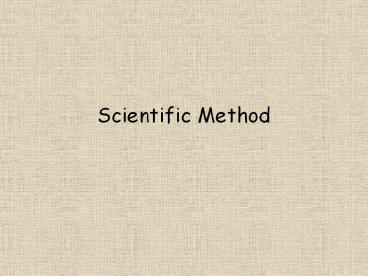Scientific Method - PowerPoint PPT Presentation
1 / 24
Title:
Scientific Method
Description:
Scientific Method What is Science? Science is a method for studying the natural world. It is a process that uses observation and investigation to gain knowledge about ... – PowerPoint PPT presentation
Number of Views:90
Avg rating:3.0/5.0
Title: Scientific Method
1
Scientific Method
2
What is Science?
- Science is a method for studying the natural
world. - It is a process that uses observation and
investigation to gain knowledge about events in
nature.
3
Scientific Method
- An organized set of investigation procedures is
called a scientific method. - Six common steps found in scientific methods are
shown.
4
Controlled Experiment
- Variables factors in an experiment that can be
changed. - Independent Variable The variable that you
change in the experiment (the amount of
fertilizer used). - Dependent Variable the variable that may change
due to the independent variable (growth in the
height of the plant).
5
Controlled Experiment (2)
- Control Group A group that is not changed in an
experiment (one plant that is not fertilized). - Experimental Group A group in an experiment
that has had one variable changed (The plants
that were given fertilizer). - Constants A factor that does not change when
other variables change (type of plant, type of
fertilizer, amount of sunlight, size of the pots).
6
(No Transcript)
7
Measurement
- Quantitative information (qualitative data would
be descriptions of your observations). - Measurements represent quantities (something that
has magnitude, size, or amount).
8
SI Measurement
- Scientist use the International System of Units
(SI).
9
SI Base Units
- There are seven SI base units (meter, kilogram,
second, kelvin, mole, ampere, candela). All
other SI units are derived from these. - Mass is the measure of the quantity of matter (SI
unit is the kilogram). Measured by using a
balance. Weight is a measure of the
gravitational pull on matter and is measured by
using a spring scale. - The SI unit for length is the meter.
10
Derived SI Units
- Derived units are produced by multiplying or
dividing standard units. - The SI unit for volume is m3 (1mL
1cm3)
11
Derived SI Units (2)
- Density is the ratio of mass to volume, or mass
divided by volume (D m/v). The SI unit for
density is kg/m3. In the lab you will usually
see density expressed as g/mL or g/cm3.
12
Conversion Factors
- Ratio derived from the equality between two
different units that can be used to convert from
one unit to another. - Example
- In one dollar there are 4 quarters
- 4 quarters or 1 dollar
- 1 dollar 4 quarters
13
(No Transcript)
14
Scientific Notation
- Numbers are written in the form M x 10n, where
the factor M is a number greater or equal to 1
but less than 10 and n is a whole number. - 65,000 km 6.5 x 104 km (when numbers are
written in scientific notation only significant
figures are shown). - 0.00012 mm 1.2 x 10-4 mm
15
Scientific Notation (2)
- M is determined by moving the decimal point in
the original number to the left or the right so
that only one nonzero digit remains to the left
of the decimal point. - n is determined by counting the number of places
that you moved the decimal point. If you moved
it to the left, n is positive. If you moved it
to the right, n is negative.
16
(No Transcript)
17
Organizing Data
- A graph is a pictorial representation of
information recorded in a data table. It is used
to show a relationship between two or more
factors.
18
Types of Graphs
- Line graphs are best for displaying data that
changes. It best shows the relationship between
two variables. A variable is anything that can
change in an experiment. Line graphs are made
with the x-axis showing the independent variable
(manipulated variable) and the y-axis showing the
dependent variable (responding variable).
19
Types of Graphs (2)
- Bar graphs are best for comparing data for
several individual items or events. Bar graphs
use a series of columns to display data.
20
Types of Graphs (3)
- Pie charts are best for displaying data that are
parts of a whole.
21
(No Transcript)
22
Density
- Density is a physical property of a substance.
Physical properties can be observed or measured
without changing a substance. - Other physical properties of substances include
shape, color, odor, and texture.
23
Calculating Density
- Density is calculated by dividing an objects
mass by its volume. - Density mass/volume or
- D m/v
24
Low and High Density
- A substance with a low density is referred to as
being light. An example is Styrofoam. - A substance with a high density is referred to as
being heavy. An example is iron. - Density of a liquid is reported in grams per
milliliter (g/ml) and a solid is reported in
units of grams per cubic centimeter (g/cm3).































